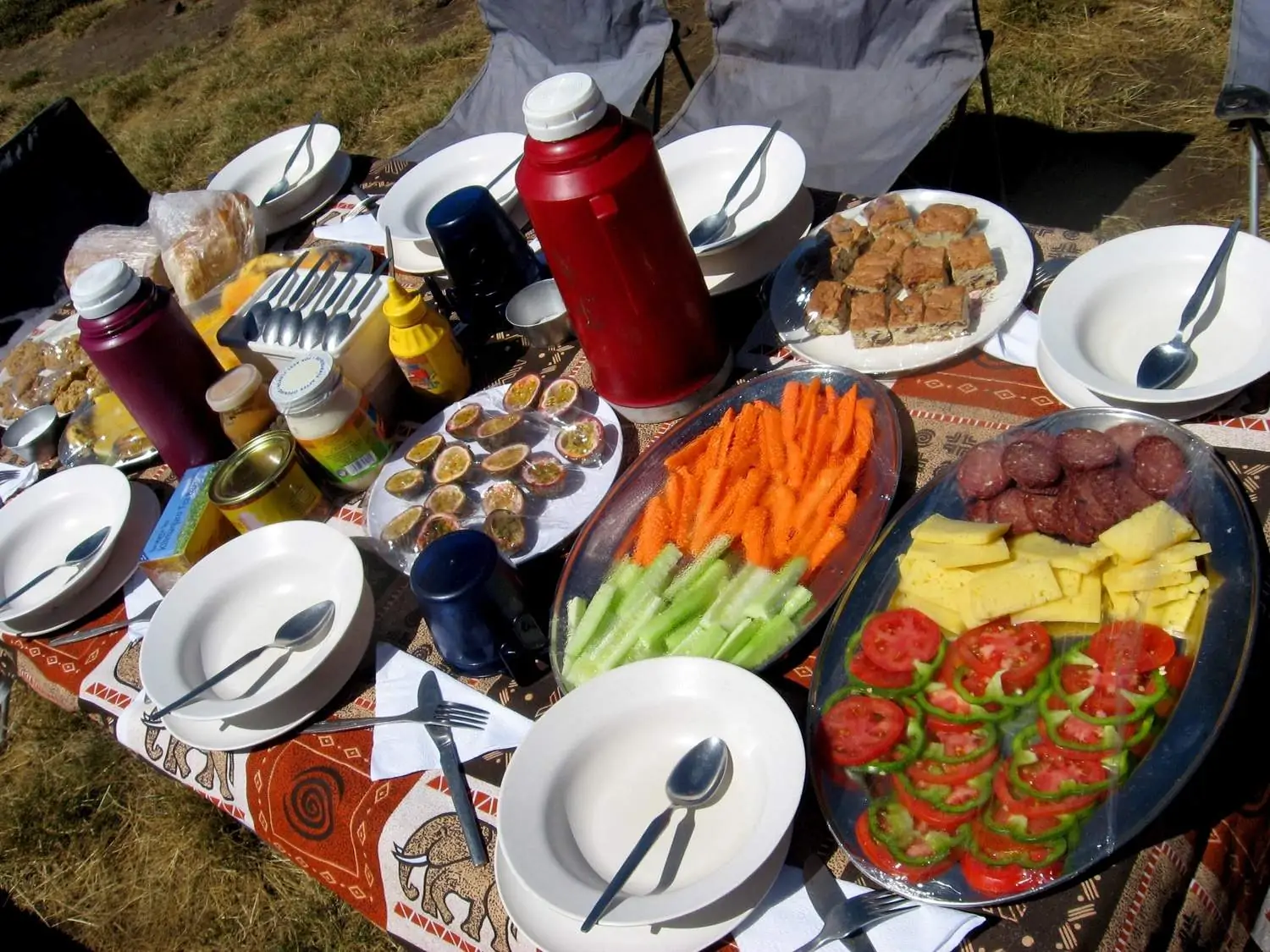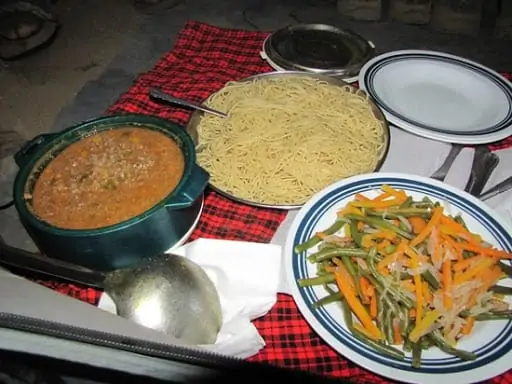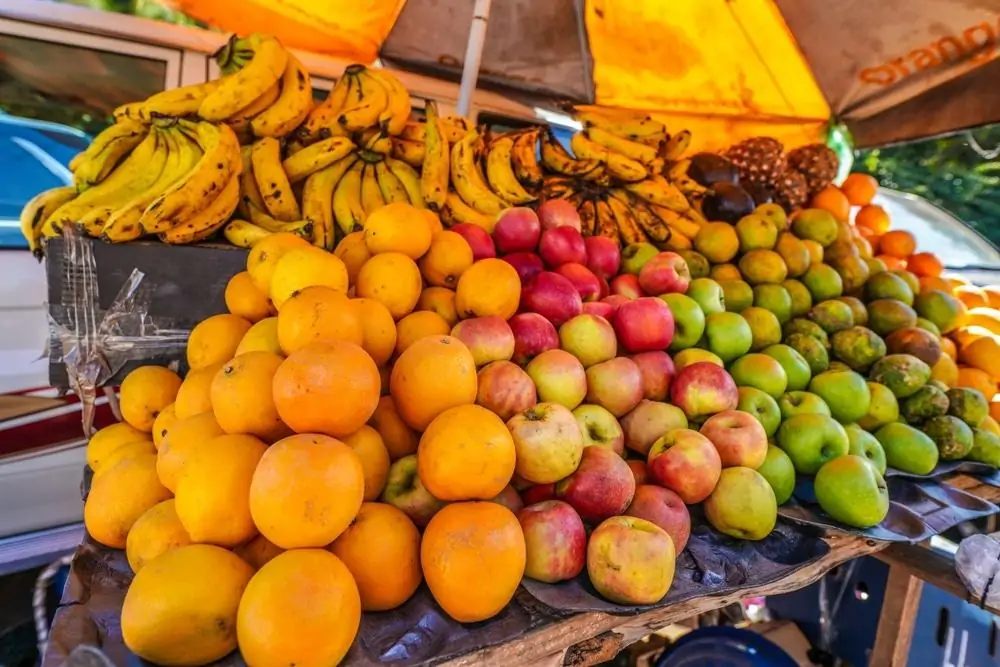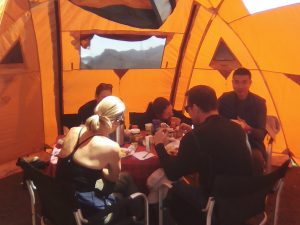
When you book a trip on Kilimanjaro, you may wonder if you need to buy a lot of extra snacks to pack with you. You may be concerned that you won’t like the food on your trip, that your special dietary needs will not be met, or simply that you won’t be able to get enough to eat. These are reasonable concerns as proper nutrition is important on any trek or climb. It becomes even more important when your goal is to reach the top of 19,341 foot Mount Kilimanjaro.
Food serves many purposes.
First: it provides nutrients your body needs to be healthy and strong.
Second: there is emotional comfort in eating food that is tasty and familiar.
Third: taking time to sit down and dine together with companions is fun and relaxing.
Peak Planet takes all of these factors into consideration.
High Altitude Nutrition Requirements
 Hiking at this elevation requires special attention to diet that might be different than when you are at home or at work. At home you may normally follow a diet that is low in carbohydrates or a diet that is low in fat.
Hiking at this elevation requires special attention to diet that might be different than when you are at home or at work. At home you may normally follow a diet that is low in carbohydrates or a diet that is low in fat.
Climbing a mountain is not the time to be on a diet. Your body will need all three nutrient groups (carbohydrates, proteins, and fat) to make it to the top of Kilimanjaro.
Complex and simple carbohydrates that are easy to digest provide a quick source of energy while you are walking.
Proteins and healthy fats take longer to digest and provide sustained energy, aid in the body’s recovery process (repairing sore muscles and joints), and help keep you warm at night.
The food served on the mountain are thoughtfully designed to have the right balance of these nutrients.
You will be served three hot meals per day with a wide variety of fresh foods to choose from. This includes carbs like cereals, breads, and pastas for quick, easy energy, and plenty of items such as meats and cheeses for sustained fuel and recovery. Additionally, snacks are provided to eat on the trail or between meals at camp.
I personally packed snacks to bring with me on Kilimanjaro and didn’t eat any of them. There was always more than enough satisfying food and snacks. The volume of food available for you is enormous!
The Importance of Hydration

Proper hydration is critically important when hiking at high altitudes.
Plenty of fluid helps aid digestion and the absorption of the nutrients you are eating, and it lubricates those sore muscles and joints. Most importantly, it prevents dehydration, which can occur more easily at higher elevations. Staying well hydrated staves off altitude induced headaches and helps your body regulate temperature to cool off when it’s hot and stay warm when it’s cold.
Peak Planet crews provide safe boiled and/or filtered water at all meals and to fill your water bottles for drinking on the trail. Aim for two to three liters of water a day.
You may not be used to drinking that much water at home. If you are cold, you may not feel thirsty and forget to drink water. Meals provided on the mountain include hydrating foods like soups, porridge, and fresh fruit so that you get water from your meals in addition to the water you drink. Every meal also includes a wide variety of soothing warm beverages such as coffee, tea, and hot cocoa.
Finding Comfort in Foods
There is a lot more to eating good food than just the nutrients it provides.
When your body is undergoing the stresses of foreign travel, hiking, and altitude, you may not want to try a lot of new foods. You want comfort food. The meals you eat on Kilimanjaro consist of popular dishes that are familiar to Westerners. Breakfasts are traditional English breakfasts. They include eggs, ham, bacon, or sausage, as well as porridge, potatoes and/or toast. Lunches may be spaghetti with tomato sauce or burgers and fries. And dinners may be beef and rice, or chicken and pasta with vegetables. There are a wide variety of tastes so the meals stay appealing to you. This really becomes important if you begin to feel a loss of appetite due the altitude.
| Sample Dinner 1 | Sample Dinner 2 | Sample Dinner 3 | Sample Dinner 4 |
|---|---|---|---|
| Fresh Butternut Soup | Fresh Cucumber Soup | Leek Soup | Egg-Drop and Noodle Soup |
| Spaghetti with Marinara Sauce | Grilled Chicken with Mushrooms | Beef Stroganoff | Beef & Vegetable Stir-Fry |
| Cooked Spinach | Roasted Potatoes and Carrots | Steamed Green Beans | Steamed Rice |
| Baked Pineapple and Pancake | Cake and Mixed Fruit | Fruit Salad | Banana Fritter |

Some clients are understandably concerned about potential risks of food poisoning or other digestive issues. After all, no one wants to get sick in the middle of a mountain trek! Westerners are often told to be concerned about eating fresh fruits and vegetables when they travel to other countries. Peak Planet mountain crews maintain hygienic conditions when handling and preparing food. Produce is washed with boiled or filtered water. And hot meals are brought to proper temperatures to kill all bacteria and pathogens.
For the clients, there is always a hand washing station set up outside the dining tent. Hand santizer use is actively encouraged.
I felt perfectly safe eating all of the fresh fruits and vegetables. The fresh, seasonal tropical fruit was an amazing treat and a wonderful way to sneak in some extra hydration.
Peak Planet is also able to accommodate special diets. I am a vegetarian. All meals included one meat entrée, one high protein veggie entrée, side dishes, soups, breads, salads, desserts, and beverages. It was super easy for me to get filling, satisfying meals.
The Dining Experience with Friends

On Kilimanjaro, our meals are shared in large, comfortable dining tents with tables and chairs. It is so nice to relax and enjoy these special times at a slow pace. It starts with soups, snacks, and hot beverages then moves on to the main courses and then desserts. You feel guilty for eating so well!
Socializing is important in every culture. This is one of the best parts of the trip and where so many memories will be made. Sitting around a table, eating, and laughing with all of your travel companions. This is where you get to know each other, you support and encourage each other, and by the end of your journey you have made new friends.
I still keep in touch with most of the friends I made on my trip.
What you eat on Mount Kilimanjaro needs to meet your nutritional and dietary requirements, but it is also so much more.
Bon Appetit!


